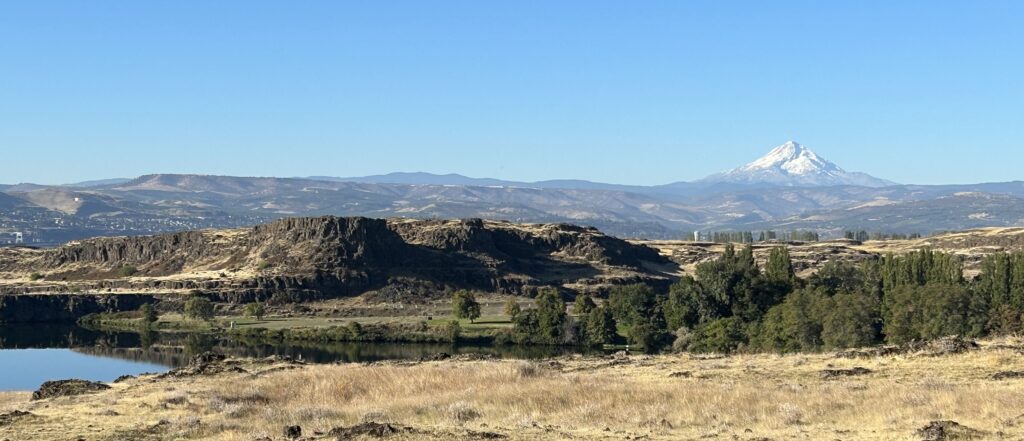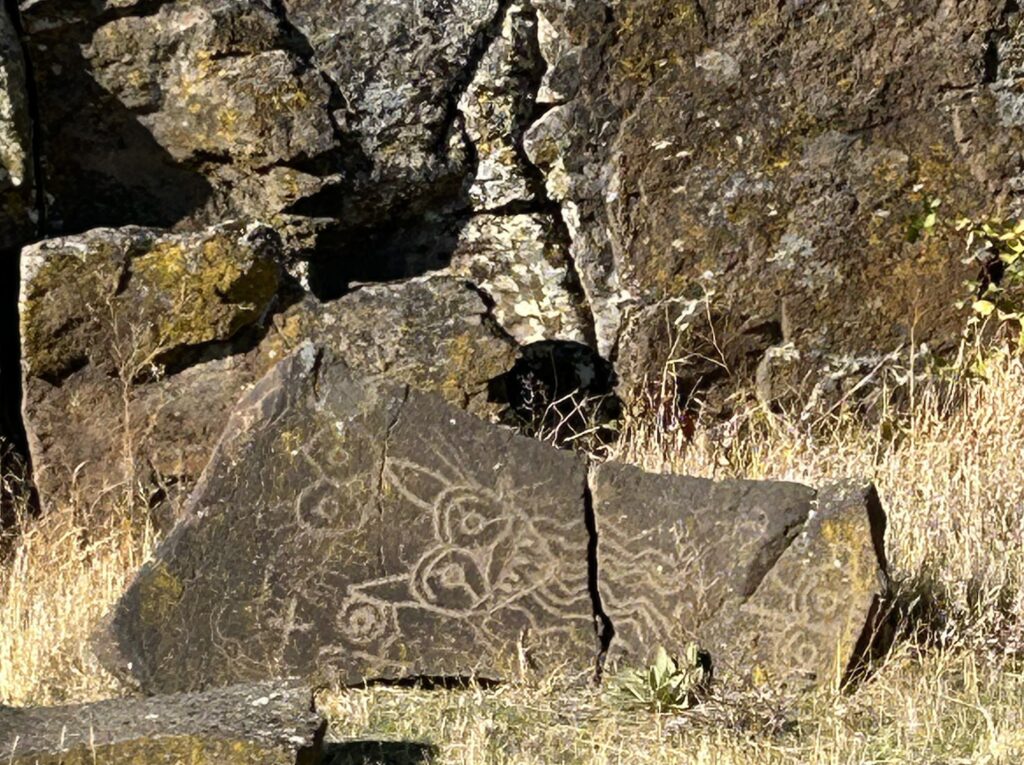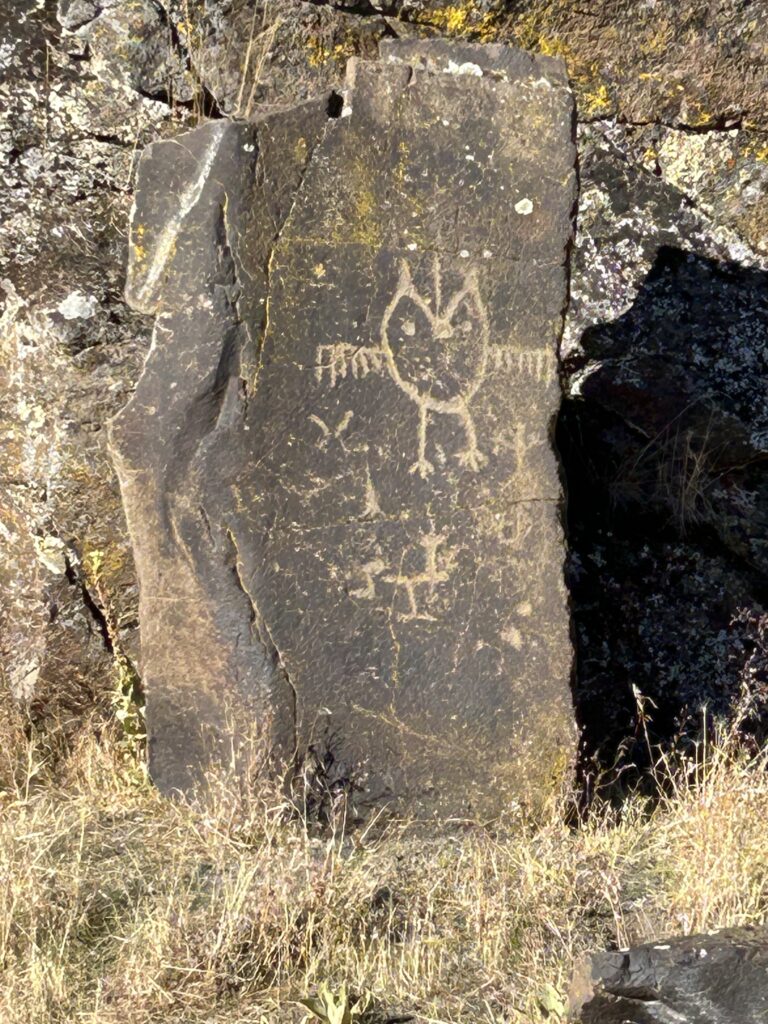One of the best ways I know to stay sane is to get out of town for an overnight vacation. I’m more relaxed when I return than when I take an extensive trip requiring weeks of preparation and delving into a catch-up list upon returning home. I am always surprised when what I think will be a familiar excursion turns into something extraordinary. Ray and I spent Thursday night hot tubbing at a Spa in the Columbia Gorge. During that day and the next, we visited a pioneer ranch and hiked along the basalt columns lining the river. The views are spectacular.

No matter how often we visit the Central Gorge area, we discover something new. We ventured into a place we had passed at least a hundred times over the past twenty years. The Horsethief Lake section of the Columbia Hills Historical State Park is a National Historic Site protecting indigenous petroglyphs thousands of years old. Following is the story of “Tsagaglalal”, She Who Watches, as told to the Park Department by Lillian Pitt, a Pacific Northwest Native American Artist whose work is influenced by ancient cliff art.


There was this village on the Washington side of the Columbia Gorge. And this was long ago when people were not yet real people, and that is when we could talk to the animals.
And so Coyote—the Trickster— came down the river to the village and asked the people if they were living well. And they said “Yes, we are, but you need to talk to our chief, Tsagaglal. She lives up in the hill.”
So Coyote pranced ups the hill and asked Tsagaglal if she was a good chief or one of those evildoers. She said, “No, my people live well. We have lots of salmon, venison, berries, roots, good houses. Why do you ask?” And Coyote said, “Changes are going to happen. How will you watch over your people?” And so she didn’t know.
And it was at that time that Coyote changed her into a rock to watch her people forever.
Following are photos I took this week.


Indigenous people lived in and around the Columbia Basin for at least 10,000 years. The earliest inhabitants of the Columbia Basins were primarily nomadic hunters relying on big game. Two thousand years later, salmon became central to their diet, culture, society, and religion. They hunted and foraged from winter villages and established seasonal camps for fishing and gathering. Anthropologists have identified thirty-two separate groups from the headwaters to the Pacific speaking six major languages.
Until recent times, tribes did not bury their dead. Instead, they wrapped them in robes, tule mats, or furs, put them in canoes or burial vaults with prized possessions, and placed them in the woods, on rocky points, or on vacant islands like the Island of the Dead not far from Horsethief Butte. A cliff near She Who Watches was used as a burial site for infants in papooses. These ancient sites were looted and destroyed when white people took over the area. Today’s Native Americans, either cremate or bury their dead in shallow graves, mounded and topped with facsimiles of artifacts meaningful to the person’s life.

Native peoples believe that souls and spirits are inextricably tied to the natural world and its inhabitants, with salmon among the most important for bringing prosperity and life to the rivers and streams. Below is a picture from the Matheny Collection of the Celilo Falls before it was flooded behind the Dalles Dam. I took the photo to the right along the Deschutes River.


Estimates vary, with reports that say 9,140 to 14,890 people lived along the banks of Columbia when Lewis and Clark passed the Celilo/ Horsethief Butte area in 1805 on their way to the Pacific. They lived in villages in multi-family houses made of planks and used ones constructed of mats and poles when traveling and hunting. Being surrounded by an abundance of wildlife, fish, roots, and berries and a good trading location on the Columbia made them very wealthy.
We need to respect the rights and beliefs of the people who occupied North America before smallpox decimated their tribes and white settlers looted, killed, and pushed them off rich tribal lands. We can no longer treat them as second-class citizens and ignore their contributions and what Americans did to them in the past.
Resources:
website. Columbia River Inner-Tribal Fish Commission. retrieved from https://critfc.org/member-tribes-overview/#:~:text=Indian
website. Northwest Power and Conservation Council: Indian Tribes. retrieved form. https://nwcouncil.org/reports/columbia-river-history/indiantribes#:~:text=A%20total%20of%2032%20separate,basin%20dating%20back%2010%2C000%20years
Estimate of Western Indians, Lewis and Clark Journals. retrieved from https://www.oregonhistoryproject.org/articles/historical-records/estimate-of-western-indians/
Michael,S. (2019) Island of the Dead .Pacific Northwest Adventures. retrieved from https://pacificnorthwestadventures.weebly.com/blog/island-of-the-dead

Read how Native American Youth and Family Services help troubled youth overcome homelessness, abuse, drugs, and gang affiliation.
Available online and in paperback in bookstores. Click to purchase on AMAZON
